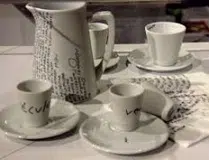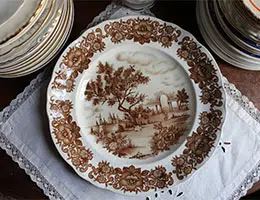 Earthenware is a material that is generally used for the manufacture of tableware . It is fired clay that is varnished to give it a better finish and greater resistance.
Earthenware is a material that is generally used for the manufacture of tableware . It is fired clay that is varnished to give it a better finish and greater resistance.
Earthenware, therefore, is generated by firing clay at a temperature between 1,000 °C and 1,300 °C with subsequent application of varnish or enamel . The result is a white paste that is porous, fine and absorbent.
In more technical terms and since the 21st century, earthenware can be defined as a porous material that is fired at a low temperature and to which a film is applied that gives it a crystalline appearance (a process that, in the field of pottery, It is known as glazing ).
The Spanish philologist and etymologist Joan Coromines i Vigneaux , known simply as Joan Corominas , noted that until 1495 the word "faience" was used to refer to vessels made of any material. On the other hand, the humanist Elio Antonio de Nebrija only associated it with baked clay.
Like any other material of ceramic origin, earthenware is made from the following materials:
* clayey mud : it is also called alumina silicate and serves as a plastic binder;
* crystalline silica : it is a degreaser that gives the paste the desired level of plasticity. It is also known as quartz sand ;
* fluxing elements : thanks to their action it is possible for a vitreous cement to form during cooking to promote the cohesion of the minerals. The most important of these elements is feldspar.
In summary, the paste used to manufacture earthenware is made up of various white clays that are mixed with calcined siliceous earths . Depending on the type of clay, the resulting color will be close to red, yellow, black or brown.
To waterproof the earthenware, a fluid varnish is used whose content contains minium, silica, galena and white lead ground in water before being fired.
By extension, the set of pieces that make up the household trousseau is called earthenware: cups, vessels, plates, bowls, etc. There are different types of earthenware depending on the techniques applied for the development of the product.
White (monochrome) earthenware is traditional. Enameled earthenware or fine earthenware , meanwhile, presents high-quality details .
Decorated earthenware , on the other hand, exhibits ornamentations that are carried out with enameled drawings, through engravings or through burnishing. In this way, the usefulness of the element is combined with beauty, since the objects can be used as decorations .
This type of earthenware is typical of Spain, and its arrival to the peninsula took place through the Córdoba artisans of the caliphate. It is worth mentioning that it took a long time until the techniques and use of earthenware were finally documented in the second half of the 13th century, after the conquest of Muslim territory.
 It is possible to recognize several style influences in Spanish decorated earthenware: throughout its history it acquired Muslim, Italian and French characteristics, among others.
It is possible to recognize several style influences in Spanish decorated earthenware: throughout its history it acquired Muslim, Italian and French characteristics, among others.
It is important to keep in mind that, beyond the ever-current popularity of china, tableware can currently include plates, platters and glasses made from porcelain , glass, wood, plastic or metal, among other materials.
Loza is also the name of two Spanish councils. One is located in the Foral Community of Navarra , while the other is in the province of Álava .
Finally, do not confuse between the earthenware (with Z ) and the slab (with S ): this second term refers to a flat stone that is used in the construction field.
